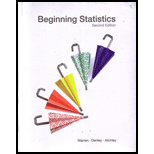
Construct and interpret a confidence interval for the true difference between the two population means.
Answer to Problem 12CR
Solution:
The confidence interval is
Explanation of Solution
Given Information:
A business person wants to determine how much faster the return trip from Dallas to Atlanta is than the initial trip from Atlanta to Dallas. He records the times for his next seven flights to and from Dallas and obtains the following data. Assuming that both population distributions arc approximately normal and the variances of the two populations are not the same.
| Atlanta to Dallas | Dallas to Atlanta |
| 1 h 49 min | 1 h 32 min |
| 1 h 51 min | 1 h 23 min |
| 2 h 03 min | 1 h 38 min |
| 1 h 47 min | 1 h 26 min |
| 1 h 53 min | 1 h 30 min |
| 2 h 01 min | 1 h 19 min |
| 1 h 45 min | 1 h 28 min |
Formula used:
When the standard deviations of both the populations are unknown and assumed to be unequal, the samples taken are independent of each other and the population distribution are approximately normal, then the margin of error is calculates as,
Where
And
The number of degrees of freedom for the t-distribution is given by the smaller of the values
Then, the confidence interval for the difference between two population means for independent data sets is given by
or
Where
Calculation:
| Atlanta to Dallas | Dallas to Atlanta |
| 109 min | 92 min |
| 111 min | 83 min |
| 123 min | 98 min |
| 107 min | 86 min |
| 113 min | 90 min |
| 121 min | 79 min |
| 105 min | 88 min |
Let the length of time the flight takes from Atlanta to Dallas be sample 1 and the length of time the flight takes from Dallas to Atlanta be sample 2.
For the population whose population variances are unequal, the t –distribution is applied for the minimum degree of freedom .i.e. the minimum of
Hence the degree of freedom is 6.
It is given that the level of confidence is 0.90 then the level of significance is,
Then,
The mean is calculated as,
Where
And n is the total number of observations.
Th mean of the sample 1 is calculated as,
The standard deviation is calculated as,
The standard deviation of sample 1 be
Substitute 112.71 for
The mean of the sample 2 is calculated as,
The standard deviation of sample 2 be
Substitute 88 for
The margin of error is calculated as,
Substitute
The confidence interval is,
Substitute 112.71 for
Conclusion:
Both the end points are coming out to be positive that is the difference of the mean is also positive that is the length timing from Atlanta to Dallas is more than the length timing from Dallas to Atlanta so the flight from Dallas to Atlanta is faster.
Want to see more full solutions like this?
Chapter 9 Solutions
Beginning Statistics, 2nd Edition
- A company found that the daily sales revenue of its flagship product follows a normal distribution with a mean of $4500 and a standard deviation of $450. The company defines a "high-sales day" that is, any day with sales exceeding $4800. please provide a step by step on how to get the answers in excel Q: What percentage of days can the company expect to have "high-sales days" or sales greater than $4800? Q: What is the sales revenue threshold for the bottom 10% of days? (please note that 10% refers to the probability/area under bell curve towards the lower tail of bell curve) Provide answers in the yellow cellsarrow_forwardFind the critical value for a left-tailed test using the F distribution with a 0.025, degrees of freedom in the numerator=12, and degrees of freedom in the denominator = 50. A portion of the table of critical values of the F-distribution is provided. Click the icon to view the partial table of critical values of the F-distribution. What is the critical value? (Round to two decimal places as needed.)arrow_forwardA retail store manager claims that the average daily sales of the store are $1,500. You aim to test whether the actual average daily sales differ significantly from this claimed value. You can provide your answer by inserting a text box and the answer must include: Null hypothesis, Alternative hypothesis, Show answer (output table/summary table), and Conclusion based on the P value. Showing the calculation is a must. If calculation is missing,so please provide a step by step on the answers Numerical answers in the yellow cellsarrow_forward
 MATLAB: An Introduction with ApplicationsStatisticsISBN:9781119256830Author:Amos GilatPublisher:John Wiley & Sons Inc
MATLAB: An Introduction with ApplicationsStatisticsISBN:9781119256830Author:Amos GilatPublisher:John Wiley & Sons Inc Probability and Statistics for Engineering and th...StatisticsISBN:9781305251809Author:Jay L. DevorePublisher:Cengage Learning
Probability and Statistics for Engineering and th...StatisticsISBN:9781305251809Author:Jay L. DevorePublisher:Cengage Learning Statistics for The Behavioral Sciences (MindTap C...StatisticsISBN:9781305504912Author:Frederick J Gravetter, Larry B. WallnauPublisher:Cengage Learning
Statistics for The Behavioral Sciences (MindTap C...StatisticsISBN:9781305504912Author:Frederick J Gravetter, Larry B. WallnauPublisher:Cengage Learning Elementary Statistics: Picturing the World (7th E...StatisticsISBN:9780134683416Author:Ron Larson, Betsy FarberPublisher:PEARSON
Elementary Statistics: Picturing the World (7th E...StatisticsISBN:9780134683416Author:Ron Larson, Betsy FarberPublisher:PEARSON The Basic Practice of StatisticsStatisticsISBN:9781319042578Author:David S. Moore, William I. Notz, Michael A. FlignerPublisher:W. H. Freeman
The Basic Practice of StatisticsStatisticsISBN:9781319042578Author:David S. Moore, William I. Notz, Michael A. FlignerPublisher:W. H. Freeman Introduction to the Practice of StatisticsStatisticsISBN:9781319013387Author:David S. Moore, George P. McCabe, Bruce A. CraigPublisher:W. H. Freeman
Introduction to the Practice of StatisticsStatisticsISBN:9781319013387Author:David S. Moore, George P. McCabe, Bruce A. CraigPublisher:W. H. Freeman





